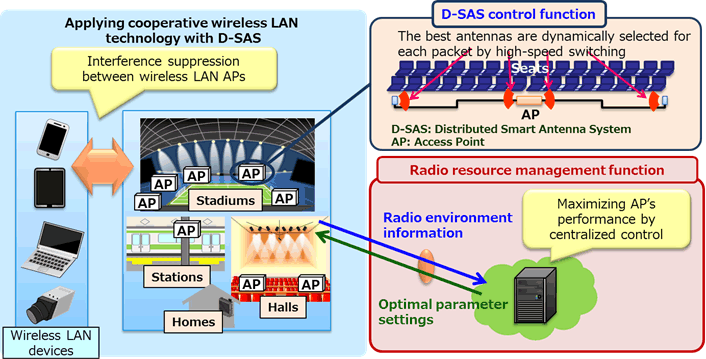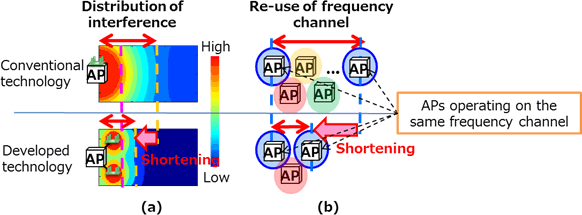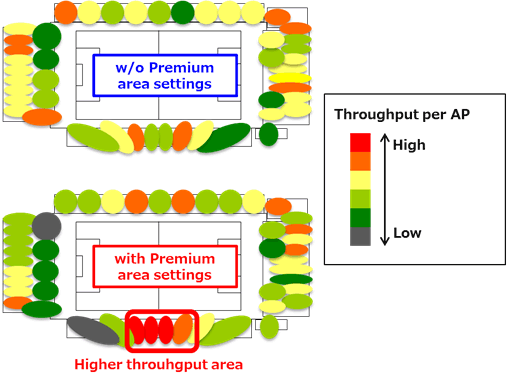Microsoft ends support for Internet Explorer on June 16, 2022.
We recommend using one of the browsers listed below.
- Microsoft Edge(Latest version)
- Mozilla Firefox(Latest version)
- Google Chrome(Latest version)
- Apple Safari(Latest version)
Please contact your browser provider for download and installation instructions.
October 19, 2017
Development of Cooperative Wireless LAN Technology with Distributed
Smart Antenna System for High Density Scenarios
~ Successful field trial in a stadium ~
Nippon Telegraph and Telephone Corporation (Hereafter NTT: Headquarters: Chiyoda-ku, Tokyo, President and CEO: Hiroo Unoura) announced the development of "Cooperative wireless LAN technology with distributed smart antenna system (D-SAS)." This development enables improved throughput in massive wireless LAN environments such as stadiums, where there are a lot of smartphones, tablet devices, laptop PCs and so on. Results obtained in a field trial confirmed the system throughput is more than twice that of the conventional technology. The developed technology consists of two key points. The first is a D-SAS control function that is installed in an access point (AP) and selects overhanging distributed antennas adaptively. The other is a radio resource management function that is installed in a network server and sets the optimum parameters of APs in a centralized manner. Through a field trial conducted in a stadium, NTT has confirmed that this technology outperforms other world-class wireless LAN solutions, and NTT continues exploring other scenarios including train stations and shopping malls in order to provide various services such as streaming and new applications.
(The developed technology will be presented at Tsukuba Forum 2017, (Tsukuba-city, Ibaraki, Japan: Oct. 19-20, 2017: https://www.tsukuba-forum.jp/e/index.html.)
Background
In recent years, smart devices such as smartphones and tablet computers using wireless local area networks (LANs) that employ APs (access points) have been rapidly increasing. This has enabled expanding broadband applications such as streaming and data downloading to be done anywhere. Therefore, the APs are also tending to increase and be densely deployed so that enough connectivity will be available for such devices. However, the frequency resources available for wireless LANs are limited, and hence APs have to share their frequency channels with those of other APs in dense environments such as stadiums, shopping malls, and stations. As a result, the overlapping service areas give rise to interference that degrades the system throughput. To overcome this problem, it is important to set radio resource parameters including frequency channel and bandwidth so that the interference is reduced.
NTT developed a technology called "cooperative wireless LAN with distributed smart antenna system (D-SAS)*1" to suppress such interference and to maximize the overall system throughput (Figure 1). The technology consists of two key functions. One performs centralized radio resource management by taking information about the surrounding radio environment into consideration and the other optimizes parameters dynamically with the aid of the first function so that the interference is reduced at each AP. NTT has been researching and developing ways to utilize this technology, which achieves the highest system throughput yet attained.

Cooperative wireless LAN technology with D-SAS
This technology suppresses the interference at each AP as well as the overall interference with the aid of two key functions; (1) D-SAS control function, and (2) radio resource management function.
(1)D-SAS control function
To achieve higher throughput where many stations (STAs) exist, APs need to be installed densely. However, the system throughput under conventional APs with co-located antennas peaks due to severe interference between APs. Although it is conceivable that the transmit power control of APs can be adopted to suppress interference, the throughput of STAs at the edge of the service area degrades due to insufficient received signal power and the frequent occurrence of the well-known hidden node problem.
To address this problem, NTT has developed D-SAS control function in cooperation with Broadcom Inc.. Broadcom Inc. developed a smart antenna control function where a wireless LAN module outputs radio frequency (RF) control signals on a packet-by-packet basis. NTT developed a distributed massive antenna architecture along with an RF device control algorithm and an RF control signal designed to enable the best antenna selection with the optimized RF settings for each wireless LAN packet. Antennas of the D-SAS AP can be placed anywhere in the service area to shorten the distance between AP antenna and STAs, and the D-SAS control function selects and sets the optimum antennas and attenuator values for each STA using the RF device control algorithm. As a result, the D-SAS AP can reduce its excessive power of transmit signals towards STAs without degrading the throughput performance, and also essentially suppresses its interference to other APs, as shown in Figure 2(a).
(2)Radio resource management function
As stated above, many APs are needed to support massive devices using the wireless LAN in crowded places such as stadiums, schools, shopping malls, and train stations. Conventional APs, however, cannot achieve their best performance due to the autonomous distributed parameter selection manner that leads to improper resource usage where the same frequency and spatial resources are used by many APs while some resources remain unused.
The radio resource management function constructs a per-antenna based virtual wireless LAN domain by using radio environment information such as the received signal power of interfering APs obtained from APs and shortens the re-use distance of radio resources to achieve higher system throughput as shown in Figure 2(b). In this process, the RATOP algorithm*2 developed by NTT outputs the quasi-optimal frequency and spatial parameter values for each AP. The function also has the ability to design flexible areas such as premium area settings where frequency channels and bandwidths are allocated in a prioritized manner to achieve higher throughput than other areas.

Results
We evaluated the performance of the developed technology at NACK5 stadium, Omiya, Japan [1]. The results are shown in Figure 3. For comparison purposes, the figure also plots the results obtained with conventional APs with co-located antennas and conventional channel settings. We placed about 150 APs under seats. All 11 channels available on the 5.47-5.725 GHz band (i.e., the W56 band) were used and the channel bandwidths of all APs were 20 MHz in both settings. We measured the throughput on a pre-selected channel by adding simultaneous TCP downlink traffic to smartphones associated with each AP operating on the selected channel. Smartphones were placed on the seats and the experiment was performed for various smartphone positions in the service area. As can be seen in Figure 3, the cooperative wireless LAN technology with D-SAS achieved throughput twice than that obtained in the conventional technology. This confirms that our technology is valid for stadium environments.

This radio resource management function can also be used in parameter configurations for commercially available APs. Figure 4 shows the performance of two channel settings for 46 commercial APs operating at NACK5 stadium, Omiya. As illustrated in Figure 4, our technology makes it possible to achieve flexible area planning in particular areas (i.e., premium areas) with prioritized parameter settings. It also enables the whole area to be optimized in terms of reducing lower throughput areas while improving overall system throughput.

Future Outlook
With the obtained results, we are striving to attain smooth commercial reality in cooperative wireless LAN technology to provide world-best solutions to wireless LAN problems in stadiums. We are also aiming to enhance super high-density wireless LAN solutions not only for stadiums but also for campuses, shopping malls, and other public areas.
"The explosion of mobile devices and the deployment of access points as the main connectivity technology to deliver content has pushed Wi-Fi into high density scenarios around the globe.", said Greg Fischer, General manager of Broadcom's Broadband Carrier Access group. "The cooperation of NTT and Broadcom for next generation system technologies, like D-SAS, enables Wi-Fi to continue to outperform all other connectivity solutions available to solve these challenges at a lower cost"
Glossary
-
Cooperative wireless LAN technology [2]
Cooperative wireless LAN technology makes it possible to use radio resources with high efficiency by means of centralized control of the APs in order to provide carrier-grade communication quality. -
RATOP algorithm [3]
The RATOP (Resource Allocation based on area Throughput Optimization Policy) algorithm calculates the quasi-optimal frequency and spatial parameters for each AP using the radio environment information observed at APs so as to improve the user throughput as well as overall system throughput.
References
-
NACK5 stadium, Omiya, URL: http://stadium.nack5.co.jp/
(Japanese).
- K. Kawamura, K. Ishihara, J. Iwatani, S. Shinohara, M. Akimoto, Y. Inoue, T. Ichikawa, and Y. Takatori, "New trends in wireless LAN and cooperative wireless LAN technology," NTT Technical Review, Jan. 2017.
- B. A. H. S. Abeysekera, M. Matsui, Y. Asai, and M. Mizoguchi, "Network controlled frequency channel and bandwidth allocation scheme for IEEE 802.11a/n/ac wireless LANs: RATOP," in Proc. of IEEE PIMRC'14, Sep. 2014.
Contact Information
Nippon Telegraph and Telephone Corporation
Information Network Laboratory Group
Public Relations Section
E-mail: inlg-pr@lab.ntt.co.jp
Information is current as of the date of issue of the individual press release.
Please be advised that information may be outdated after that point.
NTT STORY
WEB media that thinks about the future with NTT











